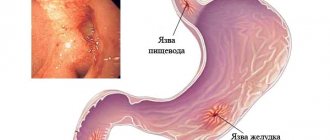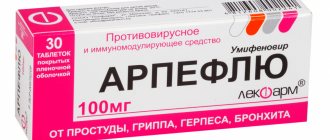Sulfadimethoxine belongs to the group of antimicrobial chemicals - sulfonamides, included in the list of essential medicines. In their action, sulfonamides are similar to antibiotics, although they are somewhat inferior in effectiveness, but are less harmful to the intestinal microflora.
Pharmacological action
Sulfadimethoxine, as a typical representative of sulfonamide drugs, has a bacteriostatic effect on pathological microorganisms. The mechanism of action is revealed by organic chemistry; the main biological component of the drug is a structural analogue of para-aminobenzoic acid , which it competitively inhibits in the formation of folic acid (a key factor in the growth and development of most microorganisms).
Thus, the synthesis of nucleic acids is suppressed (both purine and pyrimidine bases require dihydrofolic acid ), which manifests itself in inhibition of the growth and reproduction of foreign, microscopic organisms. The human cell only consumes and utilizes the metabolic product of vitamin B9 , therefore the drug does not threaten its vital activity.
Sulfadimethoxine is active against a large number of gram-positive and gram-negative microorganisms. Thus, the drug perfectly fights against pneumococci , various types of streptococci and staphylococci , dysenteric shigella , Escherichia coli and Friedlander's bacillus ( Klebsiella ). The effect is somewhat less noticeable in relation to trachoma and proteus .
Interaction with other drugs
Reduces the effectiveness of bactericidal antibiotics that act only on dividing microorganisms (including penicillins, cephalosporins).
Procaine, benzocaine and tetracaine reduce antibacterial activity.
Para-aminosalicylic acid and barbiturates enhance the antimicrobial effect.
Salicylates increase activity and toxicity.
Methotrexate and phenytoin increase the toxicity of sulfadimethoxine.
Non-steroidal anti-inflammatory drugs, thioacetazone, chloramphenicol increase the toxic effect on the blood (leukopenia, agranulocytosis).
Strengthens the effect of indirect anticoagulants, phenytoin, sulfonamides with hypoglycemic action; pyrazoline derivatives, indomethacin and salicylates increase the free fraction of the drug in the blood.
Reduces the effectiveness of oral contraceptives.
Enhances the metabolism of cyclosporine.
Myelotoxic drugs increase the manifestations of hematotoxicity of the drug.
Pharmacodynamics and pharmacokinetics
The half-life of the drug is 24-48 hours, depending on the individual characteristics of the body. Sulfadimethoxine is well absorbed by the gastrointestinal mucosa. In the systemic circulation it binds to plasma proteins, after which it is evenly distributed throughout all tissues and organs. The drug is able to penetrate the blood-brain barrier and the placenta . The favorite place of accumulation is the serous cavities of the body .
The drug is metabolized in the liver by acetylation. The solubility of products after chemical transformation deteriorates significantly and depends on the acidity of the primary urine. Sulfadimethoxine is excreted primarily by the kidneys and can sometimes lead to the formation of crystals ( crystalluria ).
Indications for use of Sulfadimethoxine
Here is a short list of what Sulfadimethoxine effectively helps with in a relatively short period of time:
- pneumonia;
- acute respiratory diseases of the upper respiratory tract;
- bronchitis with confirmed microbial etiology;
- shigella dysentery;
- sinusitis;
- tonsillitis;
- inflammatory lesions of the central nervous system ( meningococcal infection );
- pathologies of the urinary and urinary systems with a positive coccal pathogen.
Sulfadimethoxine can be used in complex therapy, when several drugs of different types are included in a conservative treatment regimen for a more complete spectrum of therapeutic action. In this case, the indications for use are expanded to include the following diseases:
- persistent forms of malaria ;
- wound infection;
- pyoderma – purulent inflammation of the skin due to coccal invasion;
- Erysipelas (or erysipelas ) is an infectious disease with characteristic erythema and bullae on the upper and lower extremities.
Indications
Indications for treatment with sulfadimethoxine include inflammatory diseases that are caused by infections sensitive to the action of sulfonamides. This drug can be used for respiratory diseases of a bacterial nature:
- pneumonia;
- rhinitis;
- laryngitis;
- tracheitis;
- bronchitis.
Sulfadimethoxine can be prescribed for diseases of the ENT organs:
- sore throat;
- tonsillitis;
- sinusitis;
- otitis.
In addition to colds and respiratory diseases caused by bacteria that are sensitive to drugs of the sulfonamide group, sulfadimethoxine helps against:
- cholangitis (inflammation of the bile ducts);
- cystitis (inflammation of the bladder);
- urethritis (inflammation of the urinary tract);
- infectious and inflammatory skin diseases (pyoderma, erysipelas);
- dysentery;
- meningitis;
- trachoma (infectious eye disease);
- gonorrhea;
- toxoplasmosis;
- festering wounds;
- malaria (in combination with antimalarial drugs).
WE RECOMMEND THE ARTICLE!
Levomycetin is used as an antimicrobial agent for the treatment of meningitis, sepsis, cholera, and typhoid fever. Read more >>
Often sulfadimethoxine is also prescribed for the prevention of inflammation in dentistry. Although this drug does not have antiviral properties, it is used to prevent bacterial complications in acute viral diseases. It is also used in combination with many antibiotics, as well as Dioxomethyltetrahydropyrimidine (Methyluracil ointment), chloramphenicol.
Contraindications
Sulfadimethoxine should be avoided if there is hypersensitivity or intolerance to individual components of the drug, hereditary or acquired deficiency of glucose-6-dehydrogenase , azotemia of various etiologies.
Under the close supervision of qualified medical personnel, the drug should be used if there is a history of diseases of the hematopoietic system or decompensated forms of heart failure .
Side effects
Conservative treatment is usually well tolerated if treatment is carried out in an inpatient setting. Otherwise, such undesirable reactions as:
- Headache and dizziness .
- Dyspeptic digestive disorders (dry mouth, nausea, vomiting, diarrhea ).
- Drug fever is a sharp rise in temperature immediately after taking the drug.
- Skin, itchy rashes.
- Leukopenia – a decrease in the level of free leukocytes in the systemic circulation, and as a consequence a decrease in the body’s resistance.
- Cholestatic hepatitis is an inflammatory disease of the liver with stagnation of bile in the excretory ducts.
- Allergic reactions - urticaria , dermatitis , angioedema or others.
Separately, it is worth noting that Sulfadimethoxine forms specific crystals in the urine, from which the tablets change its color to rich yellow-brown at a certain acidity, due to the formation of specific crystals.
Instructions for use of Sulfadimethoxine (Method and dosage)
First of all, you should test the sensitivity of the pathogenic microorganisms that caused the disease, because not all strains of coccal infection respond to treatment with sulfonamide drugs.
The tablets should be taken orally at 24-hour intervals. The course of treatment ranges from 7 to 14 days, depending on the pathophysiology of the disease. The doctor will prescribe how to take the tablets in each specific case, but the general regimen for adults is 2 grams on the first day of hospitalization and 1 gram each to maintain a stable level of the biologically active component in the systemic circulation.
The instructions for Sulfadimethoxine are somewhat different in pediatric practice . On the first day, 25 mg/kg is prescribed, and then 12.5 mg/kg in subsequent days for young children. If the child is over 12 years old, then the initial dose is 1 g, and the maintenance dose is 0.5 g.
Overdose
The state of oversaturation of the body with the drug is clinically manifested in intense thirst , severe dry mouth , small amounts of rich yellow-brown urine , pain in the right hypochondrium (liver projection) and lower back (renal localization). Biochemical analysis will reveal a significant increase in enzymes such as AST , ALT and acid phosphatase .
Therapeutic measures for overdose:
- Reflexogenic initiation of vomiting.
- Gastric lavage or high cleansing enema.
- Oral astringents and adsorbents.
- Saline laxatives.
- Forced diuresis , if the drug has managed to be completely absorbed from the gastrointestinal tract.
Adverse reactions
The following side effects may sometimes occur when taking Sulfadimethoxine:
- nervous system disorders
- depression, dizziness, headache, insomnia or, conversely, drowsiness, slight decrease in intracranial pressure, convulsions, psychosis, increased fatigue, aseptic meningitis, ataxia, optic neuropathies; - skin problems
- urticaria, erythema nodosum, photodermatitis, allergic and exfoliative dermatitis; - problems with the respiratory system
- fibrosing alveolitis, the appearance of infiltrates in the lungs; - liver disorders
- hepatomegaly, cholestatic syndrome, increased activity of liver enzymes, hepatonecrosis, jaundice; - problems with the gastrointestinal tract
- dry mouth, nausea, intestinal upset, symptoms of pancreatitis, vomiting, pseudomembranous colitis, lack of appetite; - disorders in the urinary system
- dark urine, renal failure, crystalluria leading to the formation of kidney stones, tubular necrosis, tubulointerstitial nephritis; - problems in the circulatory and lymphatic systems
- drop in platelet and leukocyte levels, aplastic anemia, eosinophilia, hemolytic anemia (in the presence of glucose-6-phosphate dehydrogenase deficiency), agranulocytosis, hypoprothrombinemia; - the appearance of allergic reactions
- difficulty swallowing, swelling of the tongue and lips, anaphylactic shock, serum syndrome, Lyell and Stevens-Johnson syndromes, systemic lupus erythematosus; - general disorders
- drug-induced fever, pain in the right hypochondrium, lower back; - as well as hypothyroidism, myocardial inflammation, drop in sugar levels, periarteritis nodosa.
If any of these adverse reactions occur, immediate cessation of medication is required.
When treating with sulfadimethoxine, you need to drink more fluids to avoid the development of urolithiasis.
One of the undoubted advantages of sulfadimethoxine is the absence of such a side reaction as inhibition of intestinal microflora, which distinguishes this drug from most antibiotics.
Interaction
Sulfadimethoxine should not be combined with:
- Drugs that inhibit hematopoiesis (for example, butadione or analgin ).
- Oral sugar-lowering agents ( sulfonyl urea ).
- Derivatives of para-amine benzoic acid (local anesthetics of the novocaine ).
The effect of pharmacological drugs will be enhanced if, in addition to the main component of the therapeutic course, the following are used:
- non-steroidal anti-inflammatory drugs;
- antithrombotic drugs;
- barbiturates;
- vitamin K antagonists .
The effects of Sulfadimethoxine are reduced by the use of folic acid , oral contraceptives and bactericidal betalactam antibiotics ( penicillins , carbapenems , cephalosporins , etc.).
The toxicity of the drug increases:
- pyrazolone derivatives ;
- salicylates;
- methotrexate and diphenine .
Analogs
Analogs of sulfadimethoxine include other long-acting sulfonamides. Let's get acquainted with them:
| A drug | Active substance | Manufacturer | Average price in Russian pharmacies |
| Phthalazol 10 pcs. 500 mg each | phthalylsulfathiazole | Dalkhimpharm (Russia) | 20 rub. |
| Co-trimoxazole 10 pcs. 480 mg each | Co-trimoxazole [Sulfamethoxazole + Trimethoprim] | Biosynthesis JSC (Russia) | 20 rub. |
| Biseptol 20 pcs. 480 mg each | Co-trimoxazole [Sulfamethoxazole + Trimethoprim] | Polfa (Poland) | 100 rub. |
These drugs have some differences in indications, contraindications and side effects.
Sulfadimethoxine is an inexpensive antibacterial drug that serves as a good replacement for antibiotics and is less harmful to the intestinal microflora. In mild forms of infectious and inflammatory diseases, preference should be given to it, reserving antibiotics for more severe cases.
Reviews of Sulfadimethoxine
Medical reviews of the drug confirm the effectiveness of the drug in the fight against coccal infection of internal organs and skin, if the conservative course of treatment is fully complied with. Otherwise, pathogenic microorganisms develop resistance to a whole group of drugs, since all sulfonamides have a typical chemical structure.
In surgical hospitals, a complex drug ( dioxomethyltetrahydropyrimidine + sulfadimethoxine + trimecaine + chloramphenicol ) is given a good rating, since in this composition the effect of the main biologically active substance is complemented by analgesic, necrolytic and anti-inflammatory effects. The drug is the drug of choice in the treatment regimen for a large number of purulent nosological units.
Separately, it is worth noting that the following question is often found on forums: “Is sulfadimethoxine an antibiotic or not?” This misconception was dispelled by Dr. Komarovsky on his official website: “The drug has a destructive effect on pathogenic microorganisms, accordingly, based on the pharmacological definition of an antibiotic, Sulfadimethoxine is such.”
Composition and release form
Sulfadimethoxine is produced in the form of tablets with distinctive features:
- White color;
- flat round shape;
- without shell;
- with a groove in the middle.
The directly active substance - sulfadimethoxine - each tablet contains 500 mg (half a gram). In addition to it, the tablets also contain: gelatin and potato starch (as a stabilizer and filler), as well as excipients such as anhydrous colloidal silicon dioxide and calcium stearate.



